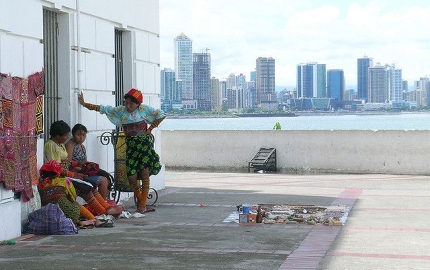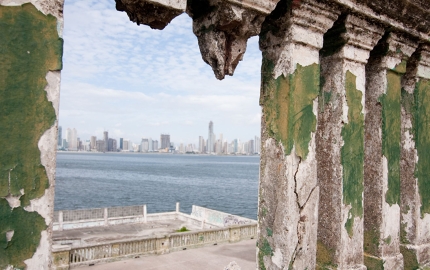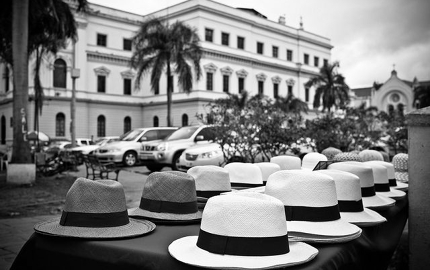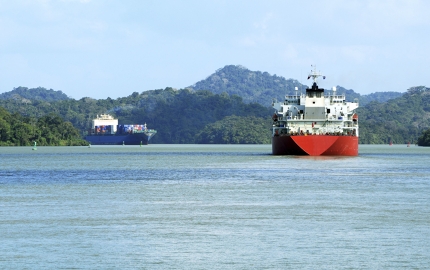Smooth sailing in new look Panama City
Sarah Gilbert takes a trip down the Panama Canal on its 100th birthday – but it’s a rejuvenated Panama City that really floats her boat.
As the heat of the day intensified, the chirps, trills and whistles rose in unison. Curtains of foliage lined the banks, as towering trees jostled for position and green reflections dappled the water of Gatun Lake.
A curious capuchin monkey suddenly emerged through the leaves, peered at us curiously for a moment before disappearing again. I looked back, and not far behind our small craft, vast-hulled cargo ships were plying their trade along the Panama Canal.
The world’s most famous short cut turns 100-years old today. While this incredible feat of engineering scores highly on many traveller’s bucket lists, there’s more to Panama City than just an historic body of water – this tropical metropolis is in the midst of an exciting renaissance and now is a prime time to visit.
A city reborn
Downtown Panama is a hub of international finance and trade. With a skyline of glittering steel and glass towers, there’s so much construction underway that the locals joke that the national bird is a crane. It’s where you’ll find the glitzy shopping malls, and the up market eateries and nightclubs of Bella Vista. “It’s like a mini-Miami – with more English spoken,” an American expat told me.
 Old ways of life cling on in a fast changing city
Old ways of life cling on in a fast changing cityCreative Commons / Lotzmana
Sitting between two oceans and two continents, Panama City has always been a trading place and across the bay from the skyscrapers are the tombstone-like ruins of the original city, Panamá Viejo.
Founded in 1519 by the Spanish, it was their base for conquering the Pacific coast of South America and later, an important link to Spain. They transported their New World gold and silver on foot and mule to Panama’s Caribbean coast for shipping back to the Old World, returning to Panamá Viejo with supplies.
All that booty attracted attention from pirates over the years, but it was finally looted and burned to the ground by British pirate Captain Henry Morgan in 1671. So the Spanish upped sticks to Casco Viejo on the southwestern tip of Panama City, which was easier to defend against attack.
Casco became a UNESCO World Heritage site in 1997 but, until recently, this mini-Havana had fallen into disrepair. Now an influx of investment is restoring the area to its former glory. I strolled along the cobblestone streets, where crumbling facades held up by makeshift scaffolding rubbed shoulders with pastel colonial mansions, now home to galleries, restaurants and bars.
“New places are opening by the week. In a few years it will be completely gringofied,” my guide remarked cheerfully.
But it would be a shame to lose the Latin, lived-in feel of this still-edgy neighbourhood. I dipped into the shade of an incense-scented church and a leafy plaza where men sold shaved ice from carts with a guttural cry. I shopped for Panama hats (actually from Ecuador) and traditional guayabera shirts, and admired the work of young designers at Diablo Rosso, a café-cum-gallery-cum- store, before heading to Ego y Narciso’s terrace for ceviche washed down with a sunset mojito or two.
 The crumbling ruins of Panamá Viejo, the old city
The crumbling ruins of Panamá Viejo, the old cityDavid Rock / Thinkstock
Movie star appeal
I was told that a familiar looking building had had a starring role in the 2008 Bond film Quantum of Solace and that during filming, Judi Dench chose to stay The Bristol, an elegant Downtown hotel, while Daniel Craig opted for Casco’s Canal House, a stylish three-room refuge, which feels more like a private house than a boutique hotel.
The Casco’s newest and largest hotel is American Trade, in a collaboration that includes the creative team behind the Ace Hotel Group. Spanning four historic buildings, it’s furnished with eclectic global finds, which is perfectly in keeping with a city that’s architectural diversity is only matched by its cultural diversity.
Around 40 different nationalities came to work on the Canal and many stayed – not forgetting the eight indigenous peoples that survived, including the Kuna ladies who sell their ‘molas’ or embroidered cloths, along the waterfront promenade.
The following day, I rented a bike and joined the locals jogging, rollerblading and cycling along the Amador Causeway, stopping to admire the brightly coloured curves of the soon-to-open Museum of Biodiversity, designed by architect Frank Gehry.
Built by the Americans with rock dug out of the canal, the causeway connects the mainland to four diminutive islands that once guarded the entrance to the canal. It was part of the US-operated Canal Zone until they handed it all back to Panama in 1999, now it’s lined with al fresco restaurants and bars.
I grab a cold beer and take a seat, admiring the views over Casco Viejo and watching ships queue up to enter the canal as they have done for the last 100 years.
 A stall in Bella Vista sells Panama hats... made in Ecuador
A stall in Bella Vista sells Panama hats... made in EcuadorCreative Commons / Dennis Tang
Fast facts: Panama Canal
• The Spanish had long dreamed of building a canal, but it wasn’t until 1881 that Ferdinand de Lesseps, the Frenchman responsible for constructing the Suez Canal, broke ground in Panama.
• In an epic story of tragedy and triumph, hundreds of thousands died from disease and landslides during its construction and, after eight years, little progress had been made and money was running out. Admitting defeat, the French made a deal with the United States in 1904 and, a decade later, on 15 August 1914, the canal finally opened.
• Stretching around 77km (47.8 miles) from Panama City on the Pacific to Colón on the Atlantic, it saves vessels from circumnavigating the southern tip of South America, a treacherous 30-day voyage of almost 12,900km (8,015 miles).
• From the rooftop of the visitors centre at Miraflores Locks, home to an interactive museum, you can watch the slow passage of enormous cargo ships through the lock – although it’s no substitute for being on the canal and seeing the locks in action.
• A full transit takes around nine hours, passing engineering feats such as the Galliard Cut, a 14km (8.7 mile) passage through solid rock. Passengers can also take a partial transit in around five hours.
• The Panama Canal cuts through Gatun Lake, which was the largest man-made reservoir in the world when it was completed in 1913. The lake's banks are a haven for wildlife including monkeys.
• Even at 100 years old, the Panama Canal still handles nearly 5% of global trade, earning Panama billions of dollars a year.
 Ships scythe through Panama's man made Gatun Lake
Ships scythe through Panama's man made Gatun LakeNancy Nehring / Thinkstock
Need to know
Getting there
There are no direct flights from London to Panama City but you can fly via Madrid with Iberia (www.iberia.com) or Miami with American Airlines (www.aa.com). Fares from around £600pp return.
When to go
The dry, summer season runs from mid-December to mid-April, and coincides with the high tourist season.
Do you have any Feedback about this page?
© 2025 Columbus Travel Media Ltd. All rights reserved. No part of this site may be reproduced without our written permission, click here for information on Columbus Content Solutions.









 You know where
You know where